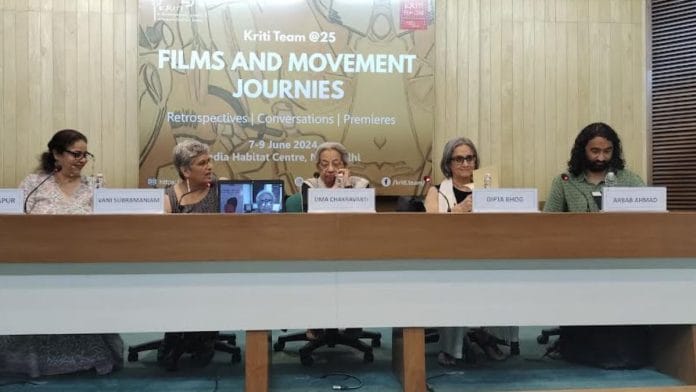New Delhi: There has been much talk about how spaces for dissent, liberal thinking, free artistic expression and federalism have been shrinking in the past decade. But the fate of the documentary film industry is often overlooked.
“Our spaces used to be the universities across the country. Those have been taken over in the last 10 years,” said historian and documentary filmmaker Uma Chakravarti at an event on political documentaries in Delhi. She said she has no screening space for her work anymore.
India Habitat Centre’s Gulmohar Hall witnessed a surge of energy Friday when it hosted filmmaking students, volunteers, and senior activists from the women’s collective Saheli. The event marked the first day of ‘Films and Movement Journies’, a three-day event to commemorate the 25th anniversary of the Kriti Film Club. The panel of speakers comprised socio-political activist Aruna Roy, women’s rights activist Dipta Bhog, and filmmakers Arbab Ahmad, Vani Subramanian, and Uma Chakravarti.
Street censorship, absence of funding, and lack of support from prominent film festivals have created a crisis for political documentaries in India. According to Chakravarti, collective spaces with students are especially important for both people’s movements and documentary screenings.
“Those spaces are shrinking. We have to fight to retrieve them.”
No screening, no discussion
After making four sponsored films, Chakravarti struggled to obtain funding for new projects. So she decided to fund her subsequent documentaries herself, calling them “pension pictures” humorously.
“I have not screened some of those films in Delhi,” she said. “These are films that are very critical. And if there is no screening space, there is no discussion around them. There is no dialogue, there is no debate.”
Chakravarti called it a “crisis moment” for political documentary makers. She went on to mention a film on farmer’s protests in the US, the venue for which was jam-packed with “every Leftern democratic banda (person) in the city”.
She was pleased with this response but also saddened that her documentaries on women’s movements received nowhere near the access. “It was also cutting the issues that I was raising.”
Also read: Elephant Whisperers’ fight shows Indian documentaries need better contracts, IP regulations
Documentaries helped RTI movement
Aruna Roy opened the conversation by emphasising the role of documentaries in the Right to Information movement. She recalled the “incredible theatre and drama” of the first RTI public hearing held in Rajasthan in 1994. It centred around the issue of a panchayat officially declaring a building complete in its paperwork. The reality, though, was visible to those who had gathered at the spot—a wobbly, unfinished structure with no doors and windows.
This grand irony had to be captured on film. So documentary filmmaker Anurag Singh set out to follow the movement, capturing protest yatras, bhajan mandalis, and hearings. “That is not only archival material today, but it’s very powerful visual material”, said Roy about Singh’s work.
So, documentaries were not just evidence but also a means of communication that strengthened the movement by reaching “unconverted audiences”, as sutradhaar (moderator) Aanchal Kapur called them.
Arbab Ahmad, however, said he looked at movement differently. His documentary Insides and Outsides captured the collaborative social spirit of the Shaheen Bagh protests, and how it gave way to the oppressive isolation of the Covid-19 lockdown. Speaking in the context of his film, he said that he saw ‘movement’ as the migration Muslims were historically forced to undertake to escape violence, which pushed them into smaller and smaller localities.
Protest for Ahmad, then, meant standing one’s ground in the face of forced movement. A poignant scene in Insides and Outsides featured him in a closed room—reading name after name of Muslim persons subjected to mob lynching, and saying a brief prayer for them. While he read, his mother began banging on his door, calling out his name with increasing urgency. The personal, quite literally, had invaded the political.
Also read: Deepa Mehta is back with a film on transwoman Sirat Taneja. ‘All good art is political’
‘Documentaries difficult, traumatic to make’
Making Insides and Outsides was an isolating experience for Ahmad. The documentary was his effort to humanise his identity against a state apparatus on the “warpath of erasure”. He met other Muslim filmmakers who had had a similar experience. “Everyone in isolation understood that their stories matter,” Ahmad said.
Filmmaker Vani Subramanian agreed that documentary filmmaking (documenting doesn’t read right, I think) is a difficult process. “It’s a very traumatic experience,” she said, referring to the issues filmmakers address in political documentaries.
She also asserted that she never approaches documentaries objectively. While showing inequalities, she always amplifies certain voices and disseminates a certain point of view. “Film is not just a medium of documenting (a moment), but also of documenting reflection, analysis—revisiting ourselves.”
Subramanian also mentioned that the “moment”—the time, space, and setting—in which an audience receives a film can give it a new meaning. After Lok Sabha election results, existing documentaries on Ayodhya, such as her 2007 film Ayodhya Gatha, will be received differently.
The audience applauded the mention of the election verdict. Did she share their excitement about the future? Subramanian coolly remarked that the fight had just begun.
(Edited by Zoya Bhatti)






